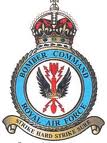 From a very early age I was always interested in the history of the Second World War – part of this almost certainly came from that fact that I had Uncles who’d been in the Army and Merchant Navy who had served in WW2, and my mother had been a ‘Fire watcher’ in my current home-city of Sheffield. I became very interested in Bomber Command after I got interested in amateur radio and electronics. The link was to do with radio; the detection of bombers by radio, the navigation technologies used by both allied and German bombers were all radio based, and RV Jones’s brilliant history of the subject ‘Most Secret War’ was an excellent read for me as a teenager. The more I learnt about Bomber Command, the more I admired the men who flew the aircraft that attacked strategic targets in Occupied Europe and Germany.
From a very early age I was always interested in the history of the Second World War – part of this almost certainly came from that fact that I had Uncles who’d been in the Army and Merchant Navy who had served in WW2, and my mother had been a ‘Fire watcher’ in my current home-city of Sheffield. I became very interested in Bomber Command after I got interested in amateur radio and electronics. The link was to do with radio; the detection of bombers by radio, the navigation technologies used by both allied and German bombers were all radio based, and RV Jones’s brilliant history of the subject ‘Most Secret War’ was an excellent read for me as a teenager. The more I learnt about Bomber Command, the more I admired the men who flew the aircraft that attacked strategic targets in Occupied Europe and Germany.
Out of a total of 125,000 aircrew in Bomber Command, 55,500 were killed during the war. The average life expectancy of a crew was 13 missions. This could easily equate to just a few months of active service. In the later years of the War, crews that ‘bailed out’ of their aircraft over Europe and that were captured by the Germans might easily fall victim to the‘Nacht und Nebel’ Decree of the Nazis, in which the captured airmen, rather than being treated as prisoners or war, would simply disappear in to the Concentration Camp system.
The commander in chief of Bomber Command was Sir Arthur ‘Bomber’ Harris was the creator of the ‘thousand bomber raids’ policy which put as many bombers as possible in to the air to overwhelm German defences. His policy of ‘Area Bombing’ – even after the accuracy of bombing techniques had improved to such a degree that the required damage could have been inflicted on German strategic targets without the massive destruction meted out to such cities as Dresden – did not go down well after the end of the War, and Harris was the only one of the senior British commanders not to receive a Peerage after the war. And Bomber Command did not have a campaign medal struck in their honour. And whilst a statue of Sir Arthur Harris was erected in the 1990s, there is still no memorial for those in Bomber Command who died performing their duty.
End of the history lesson; recently there has been continued interest and activity to get a memorial for Bomber Command crews erected, and fund raising activities are taking place. The Bomber Command Association has raised £1.5 million out of the £4 million required, and it is hoped to get the memorial erected by 2011.
It’s overdue, and something that should have been funded from the public purse. Some will look back on the activities of Bomber Command over the span of 65 years and claim that the area bombing campaign was barbaric, a war crime, an over-reaction. The generation of people who fought and died in World War 2, or who were subjected as civilians to German air raids, is obviously dying out, and with the best will in the world it’s hard for those of us too young to have been there to truly realise what it was like to live through a period of years during which their was a genuine fear of invasion and the destruction of the British way of life in a way that had never been considered before or since. Bomber Command between 1939 and 1944, and the later the United States Air Force, was the means by which the war was taken to Germany and the German industrial and economic capacity disrupted. With the benefits of hindsight, it’s easy to take the revisionist view of history; that the raids were not as effective as had been believed, that civilian damage outweighed the military impact, that the lives of the crews of Bomber Command were thrown away.
I don’t take that view; it’s way too easy (and way too common) for us to try putting the morality of the 21st Century on to the actions of previous years. The young men of Bomber Command – as young as 18 and typically in their early 20s – should be honoured before they all pass away.
Please consider giving the memorial project your support.
